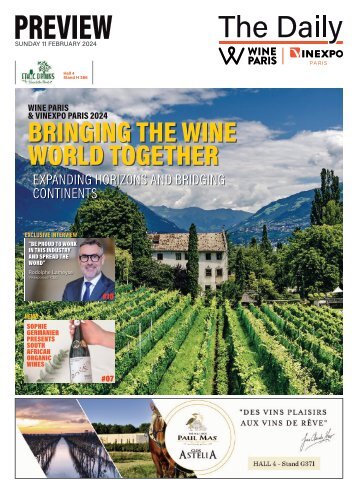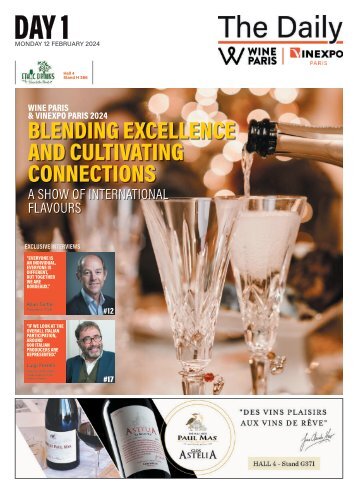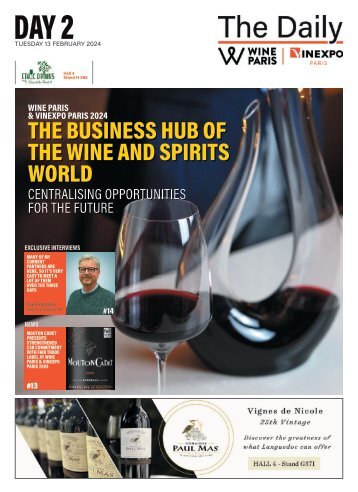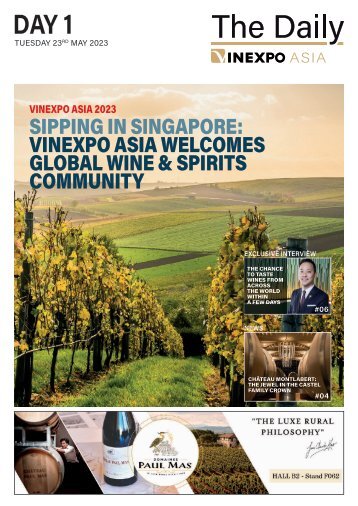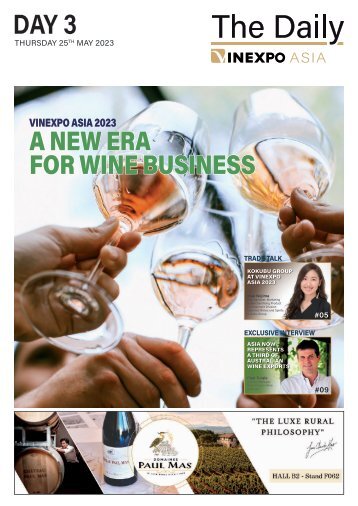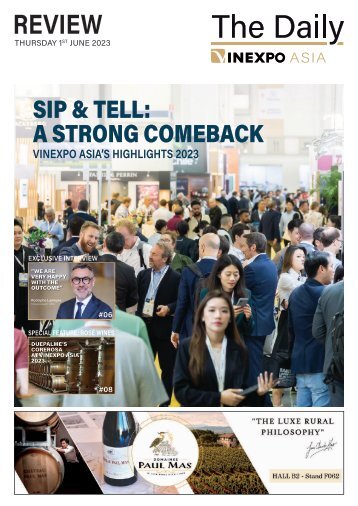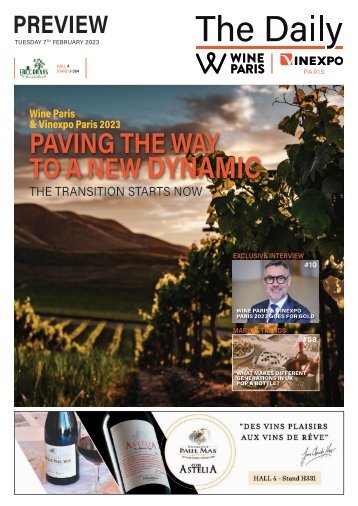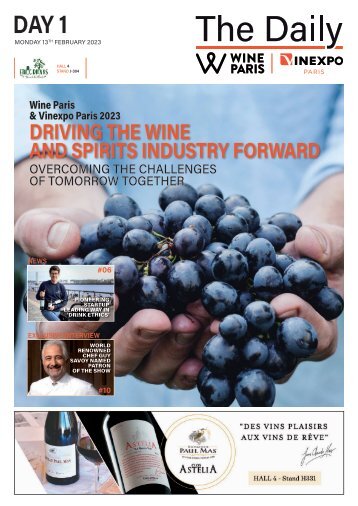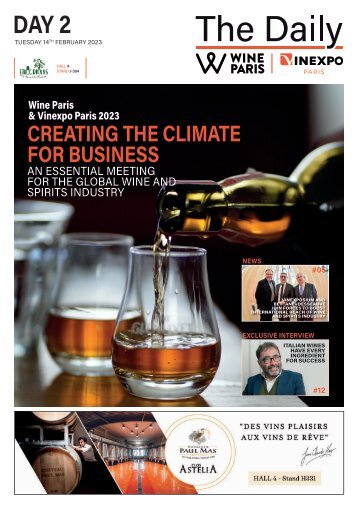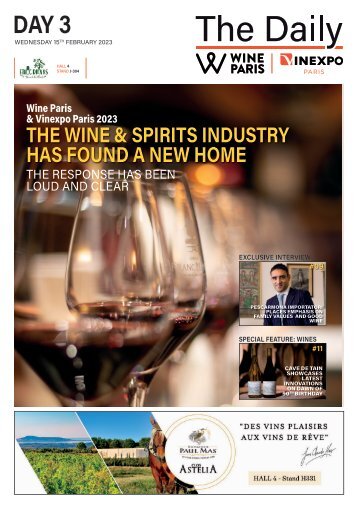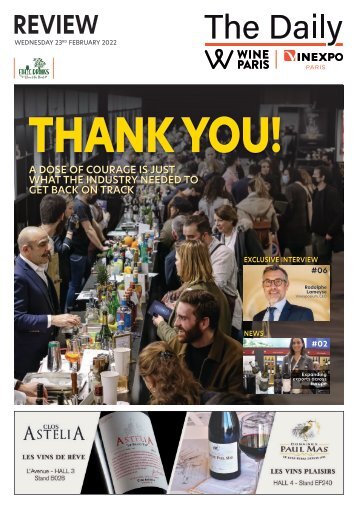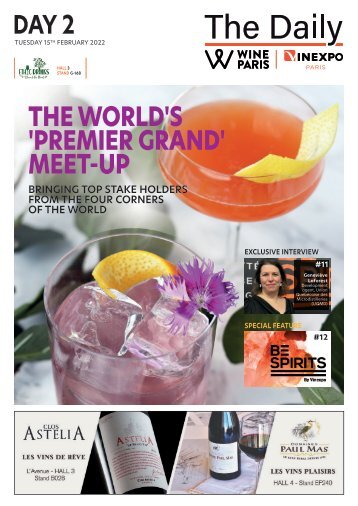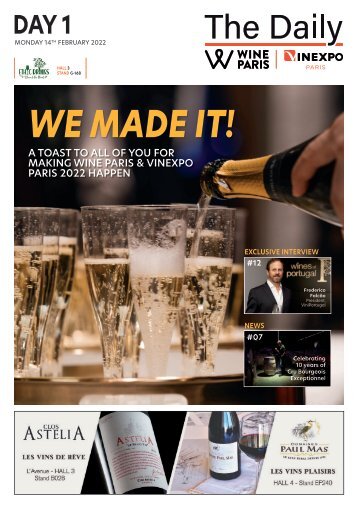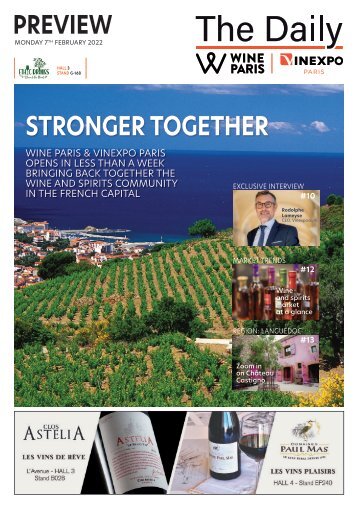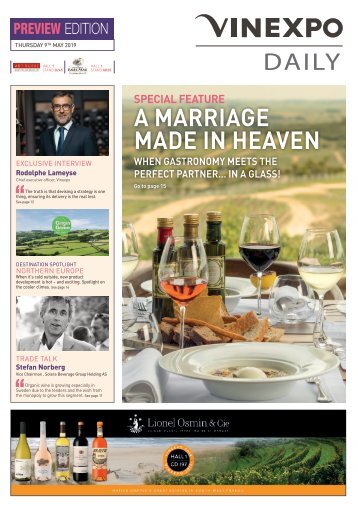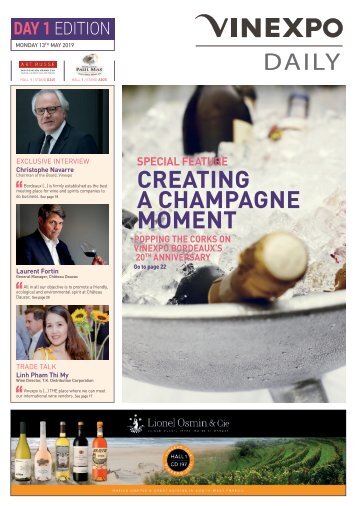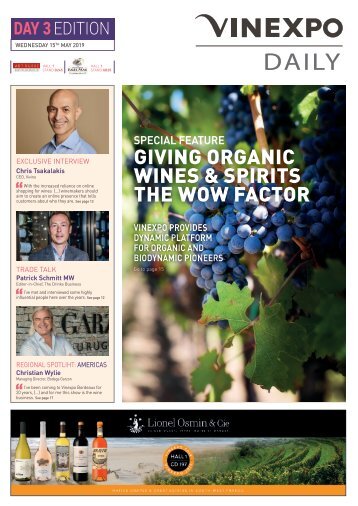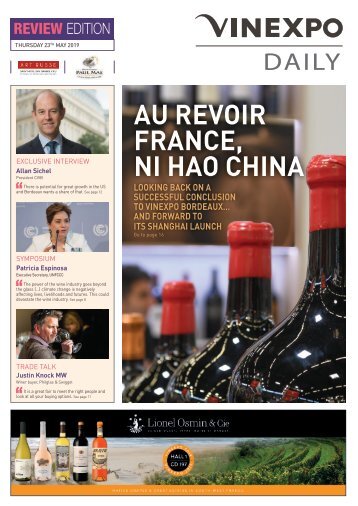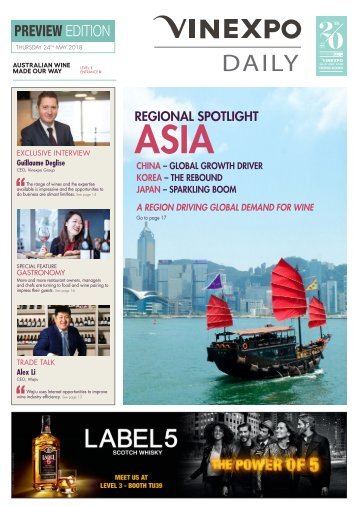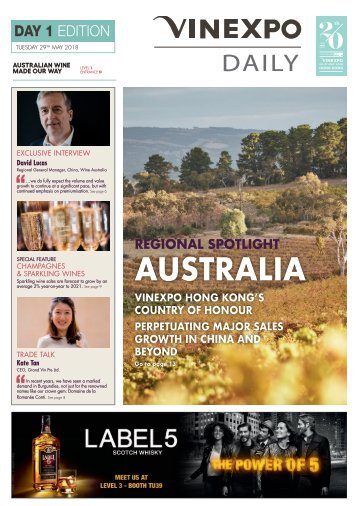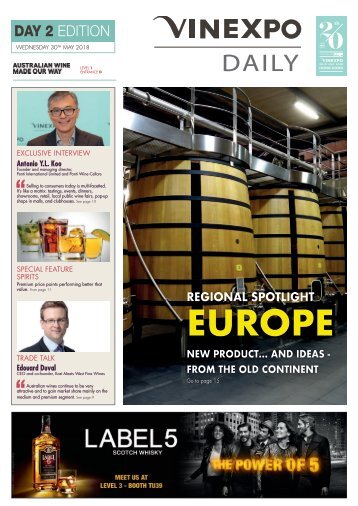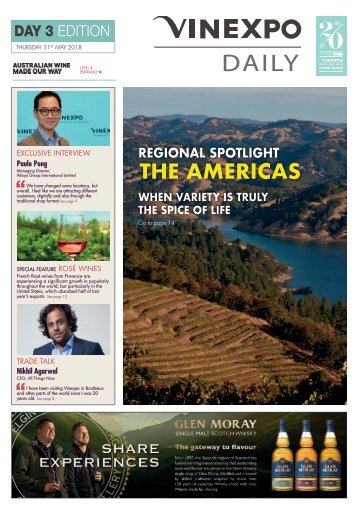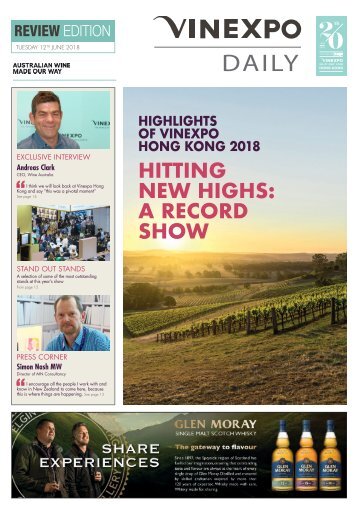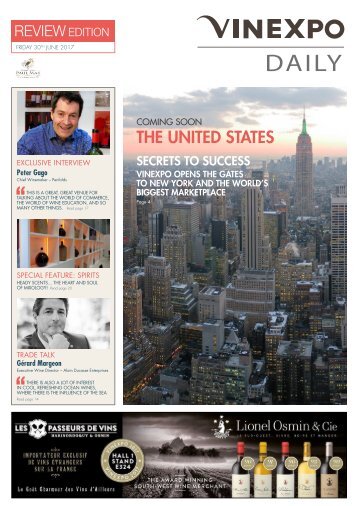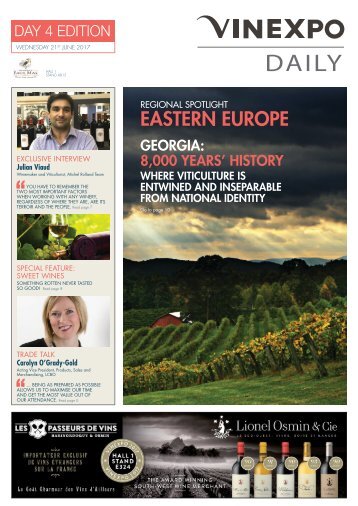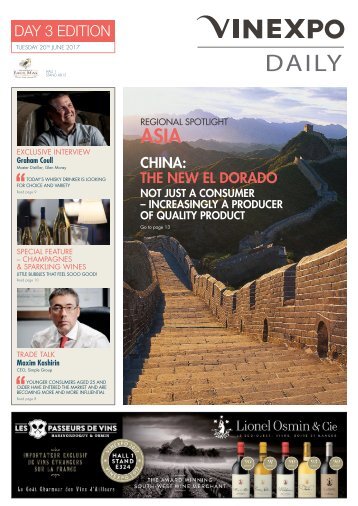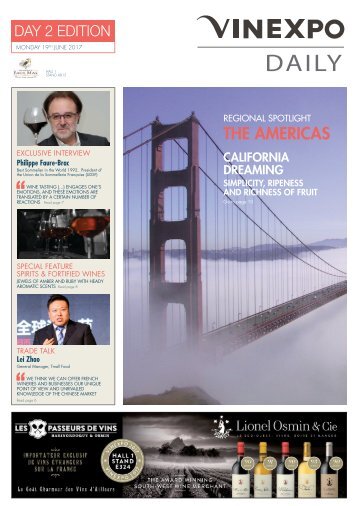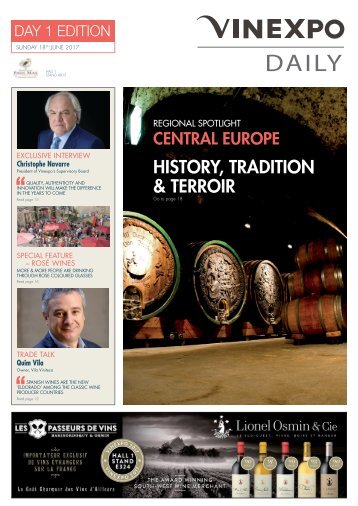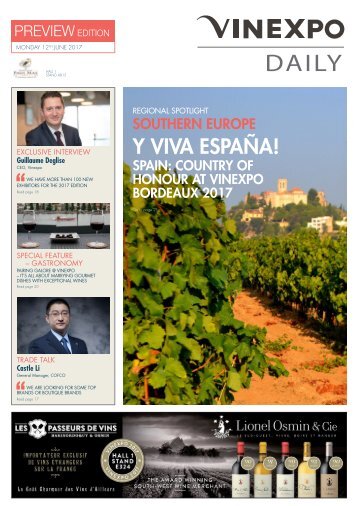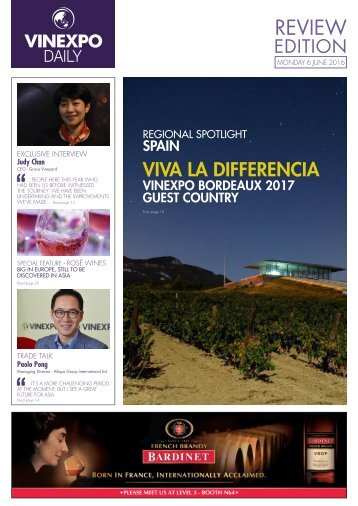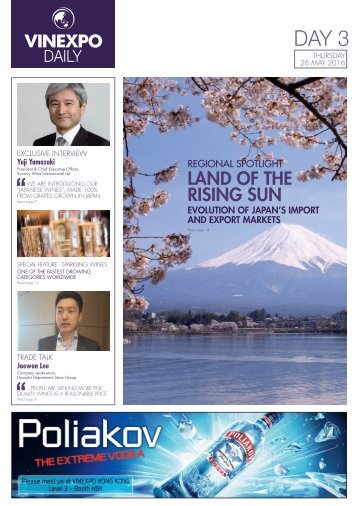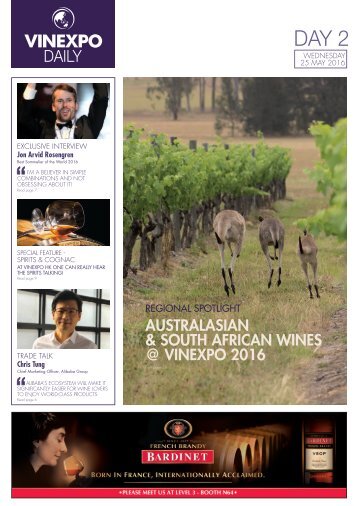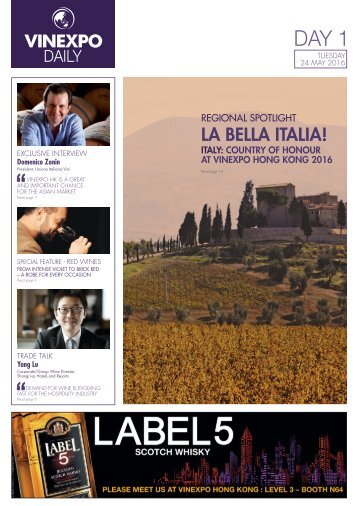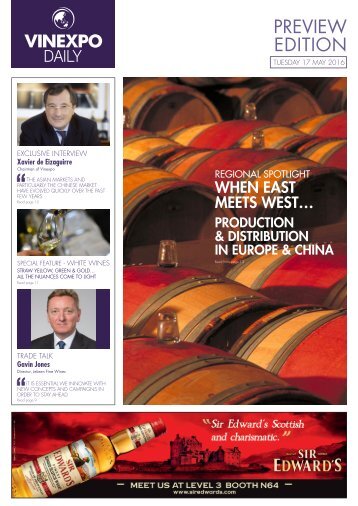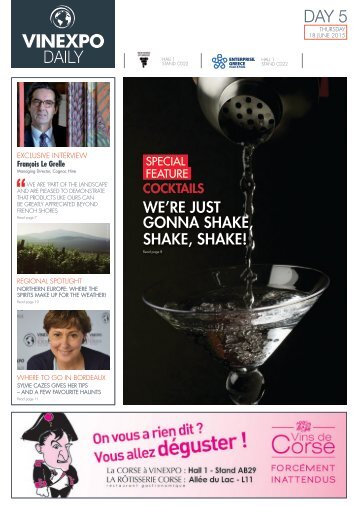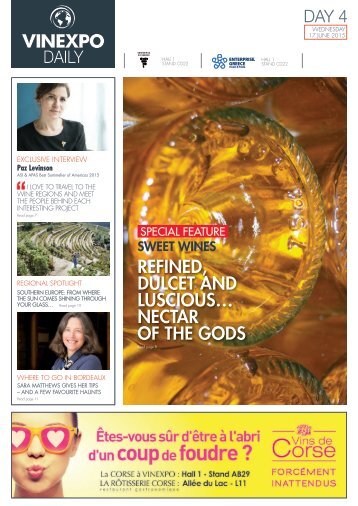Vinexpo Daily 2020 Day 1 Edition
- Text
- Craft
- Vineyard
- Armagnac
- Grapes
- Halewood
- Grape
- February
- Vinexpo
- Wines
- Organic
I SPECIAL FEATURE I
I SPECIAL FEATURE I CHAMPAGNE IChampagne Drappier launchesits organic Champagne:ClarevallisWith 15 hectares owned andfarmed organically, the Drappierfamily produces ChampagneClarevallis, a moderninterpretation of its cistercianheritage. It will be availablefor tasting for the first time atVinexpo Paris.Champagne Clarevallis, which has Ecocertcertification, is made from grapes grownon Jurassic limestone land that is farmedorganically and tilled, in part, by horse. Thenew extra-brut Champagne is producedfrom 75 percent Pinot noir grapes, 10percent Pinot meunier grapes, 10 percentChardonnay grapes and 5 percent Blancvrai or Pinot blanc grapes. It is unfilteredand has a very low sulphur contentof 20mg/l. This new Champagneis characterised by a goldengreycolour, and it has hints ofelderberry and violet in its taste.The name Clarevallis has manycenturies of history behind it,since it is the name given bySaint-Bernard to the abbeyhe founded in 1115. Thisname ultimately evolved intoClairvaux.Champagne Drappier's wineshave been vinified and aged incellars built in 1152 by monksfrom the Clairvaux abbey.It is appropriate, then,that Champagne Drappierdescribes ChampagneClarevallis as "the expressionand reflection of both thelandscape and the land that men andwomen have been tending here sincethe 12 th century".Today, the cellars are owned by theDrappier family, who establishedChampagne Drappier in 1808.The attention to detail shown indeveloping Champagne Clarevallisgoes right down to the branding,which reflects ChampagneDrappier's rich history. The labelwas designed and drawn byCharline Drappier and inspiredby the Clairvaux Bible written inthe 12 th centuryPAV 7.1 / STAND FH42Champagne Drappier'snew organic ChampagneClarevallisADVERTORIALNavigating the climate,the competition andthe rules to sellorganic Champagneacross theworldPauline andGuillaume OrbanCommercial Director,Champagne Bruno Michel(from left to right)Varying rules on the term organic, rainy springs and the rise ofProsecco are just a few of the challenges facing ChampagneMichel Bruno. We asked Guillaume Orban, Commercial Directorfor Champagne Bruno Michel to tell us more about organicchampagne.We are based south of Epernay in themiddle of Champagne and have 12hectares, half growing Chardonnayand half growing Meunier. We standout because we are one of the rareChampagne organic wines. Just 1.5%of all wine makers in Champagne areorganic because of the difficult climate,including having rainy springs, so itis hard to grow organic grapes here.We only use non-synthetic products toprotect ourselves and we have a lot moremanual labor to weed our vineyards.Why is it important for you to come toVinexpo?I come to see all my clients in one place,which Vinexpo is great for. I was at VinexpoHong Kong last year and I was very happywith the clients I met. Vinexpo also allowsme to grow my customer base, especiallyinternationally.What are some of the challenges andopportunities in the Champagnemarket?The organic label helps us a lot with theyounger generation, as they are lookingto consume wines which are produced ina sustainable way. Ten years ago less than0.7% of all Champagne was organic, sothe trend towards organic has grown a lotin recent times.The biggest challenge for us is toproduce organic wine. But then to exportinternationally we are faced with a mazeof different regulations, as each countryhas different standards and requirementsin order to have the organic label. Forexample, the United States of Americais quite complex and then Korea has adifferent set of requirements.Internationally, there is a strongcompetition from Prosecco wines, whichhave greatly increased in quality in recentyears and have very strong marketingbackingPAV 7.2 / STAND MN20712 • VINEXPO DAILY • MONDAY 10 TH FEBRUARY 2020www.vinexpodaily.com
I REGION I AUSTRALIA - SOUTH AFRICA ITonyBattagleneExecutive, AustralianGrape & WineBushfires bring actorsof Australian wine sectorcloser togetherTHE FRUITS OFAN EXTRAORDINARYPARTNERSHIPThe Rupert & Rothschild partnership wasformed in 1997 by the late Dr Anton Rupert ofSouth Africa and the late Baron Edmond deRothschild of France. Their vision was carriedforward by their sons, the late Dr AnthonRupert and Baron Benjamin de Rothschild.The founder, Dr Rupert, was an internationallyrespected industrialist who established a globalbusiness empire was held in high regard asa committed conservationist and togetherwith his art-devoted wife Huberte, played animmense role in the preservation of art. TheRupert family, with a passion for producingworld-class wine, own three other wineestates in the picturesque FranschhoekValley: La Motte Wine Estate, L’OrmarinsWine Estate and Anthonij RupertWyne. Today, at Vinexpo Paris, onecan discover the latest wares fromthis extraordinary producer, includingBaroness Nadine 2018 and BaronEdmond 2015PAVILLON 7.1 / STAND A33Australia’s wine sector is drawing together to provide support andadvice to those affected by this season’s devastating fires. WineAustralia, Australian Grape & Wine, the Australian Wine ResearchInstitute and viticultural experts, backed by the Federal Government,and state and regional wine agencies, are coordinating a responsethat will offer support and advice in the short-term and a longer-termaction plan.Wine Australia ChiefExecutive Officer AndreasClark says in some regionsof South Australia, NewSouth Wales, Victoria andQueensland, individualvineyards and wineries hadsuffered devastating damagewhich would take years torecover, and local regionsand the sector more broadlywould step in to assist. MrClark said it was important tokeep the impact of the fires incontext: “Australia is a verylarge country. A review of firemaps suggests a maximumof around 1500 hectares ofvineyards fall within the fireaffected regions to date.Even if all those vineyardswere fire damaged – andthey are not – it would onlybe about 1% of Australia’stotal vineyard area.’Australian Grape & WineChief Executive TonyBattaglene said there wouldbe a coordinated responseto both short-term relief andOUR MESSAGEIS THATAUSTRALIAIS HURTINGFROM THEFIRES, BUTWE ARE OPENFOR BUSINESSlonger-term planning.“Responses must includerelief for those directlyimpacted, including thosegrowers who might not beable to sell smoke-affectedgrapes. In the medium term,we must look to strengthenregional tourism and bringpeople back to the regions”,he said.“Our message is thatAustralia is hurting from thefires, but we are open forbusiness. We need donationsto the relief funds, supportfor our emergency services,and consumers to buy ourwine and visit our regions. Itis important to note that thefire season is not over andour temporary relief may notlast.”A number of Aussie winesare on show at Vinexpo Paris,such as Hollick Estate fromthe Coonawarra region ofSouth AustraliaPAV 7.1 / STAND HK16SOUTH AFRICA’SLONGRIDGE WINE ESTATESHINES AMONGST WORLD’STOP ORGANIC WINESOrganic and biodynamic Stellenbosch wineproducer, Longridge Wine Estate and JasperRaats have received three gold medals at theGrand International Organic Wine Awards. Theinternational awards for organic wines hasbecome one of the most important tastingevents in the global organic wine sector.The following wines received a gold medal:• Longridge Organic Chenin Blanc 2016• Longridge Organic Chardonnay 2017• Jasper Raats Single Vineyard WinesDriefontein Organic Syrah 2016PAVILLON 7.2 / STAND MN232Longridge is one of theleading wine estatesin the heart of theCape Winelands nearStellenbosch, SouthAfricaVINEXPO DAILY • MONDAY 10 TH FEBRUARY 2020 • 13
- Page 1 and 2: DAY 1MONDAY10 TH FEBRUARY2020SPOTLI
- Page 3 and 4: EDITORIALRichard BarnesEditor-in-Ch
- Page 5 and 6: I NEWS IADVERTORIALThe sure valuefr
- Page 7 and 8: ADVERTORIALIT'S THE SAMEEVERYWHERE
- Page 9 and 10: I EXCLUSIVE INTERVIEW ILooking to d
- Page 11: I SPECIAL FEATURE IChâteau Suau pu
- Page 15 and 16: ADVERTORIALI REGION I USA I© Ashto
Inappropriate
Loading...
Mail this publication
Loading...
Embed
Loading...
The Daily - Wine Paris / Vinexpo Asia
- The Daily Wine Paris & Vinexpo Paris 2024
- The Daily Vinexpo Asia 2023
- The Daily - Wine Paris & Vinexpo Paris 2023
- The Daily - Wine Paris & Vinexpo Paris 2022
- Vinexpo Daily - Bordeaux 2019
- Vinexpo Daily - Hong Kong 2018
- Vinexpo Daily - Bordeaux 2017
- Vinexpo Daily - Hong-Kong 2016
- Vinexpo Daily - Bordeaux 2015
- Vinexpo Daily - Paris 2020
- Media Kit 2019
